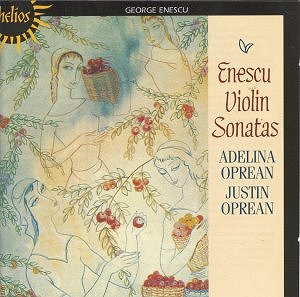Enescu has been on my 'to be explored' list ever since
I heard one of his orchestral works. It was not the famous Rumanian
Rhapsody No. 1 which I still find rather queazy. In fact it was a Radio
3 broadcast of an elderly Melodiya LP: the irrepressible Gennadi Rozhdestvensky
conducted Enescuís First Symphony. The orchestra was the Moscow Radio
SO and the performance (which I still have on tape somewhere) was nothing
short of explosive - a terrific orgiastic blast of energy.
These sonatas are, as expected, more intimate but perhaps
more enduring than the high calorific blast of the First Symphony. In
fact the Second Sonata (dedicated to Thibaud) is contemporaneous with
the Symphony. It is a songful piece in which the Rumanian composer takes
on the manner of both Brahms (especially the first movement) and his
teacher Fauré. There is an unfeigned carefree joie de vivre in
the vif last movement to contrast with the smiling inwardness
of the Tranquillo.
The so-called Torso movement dates from
1911. It is a florid rhapsodic piece striking attitudes betwixt Szymanowski
and Elgar.
This leads us naturally to the hothouse character of
the Third Sonata which has as much in common with the warm Sicilian
hedonism of Szymanowski's King Roger as with Rumanian folk music.
There is much mittel-European melisma, zigeuner flounce and Iberian
zapateado. This could so easily have been a tired and hackneyed trot
through the usual currency of gypsy eyes, glutinous serenades and flickering
fires. Instead Enescu seems to search out the essence of his country's
folkroots and from these synthesises a quasi-impressionistic language
which looks in various directions: to Ravel's Tzigane, forward
to Miklós Rózsa in the violin concerto and the avowedly
Hungarian works and to Szymanowski of the Mythes and of Harnasie.
The Opreans tear into this music with utmost commitment and emotional
dedication. Listen to Adelina in the last four minutes of the mercurial
and waywardly inventive finale of the Third Sonata. This is big and
highly-coloured music.
Good notes from Noel Malcolm, Enescu's biographer (see
Toccata Press).
Rob Barnett


